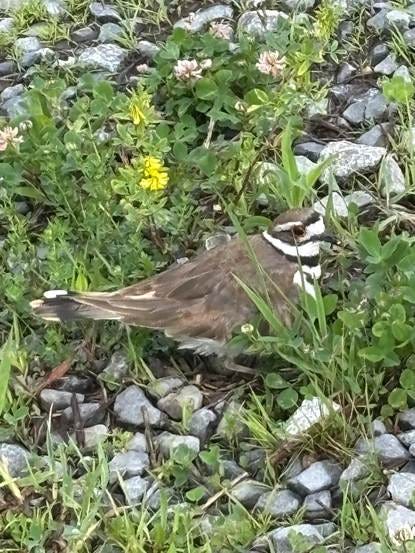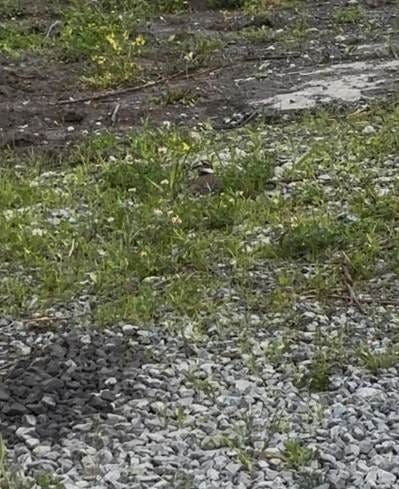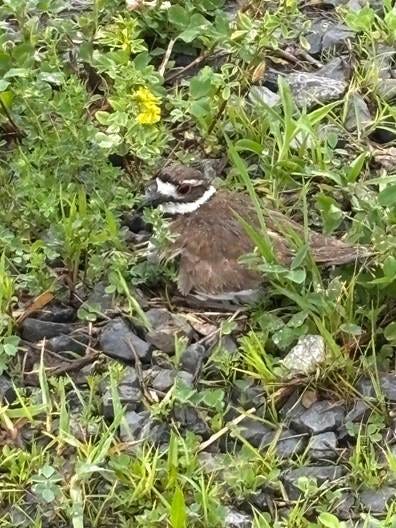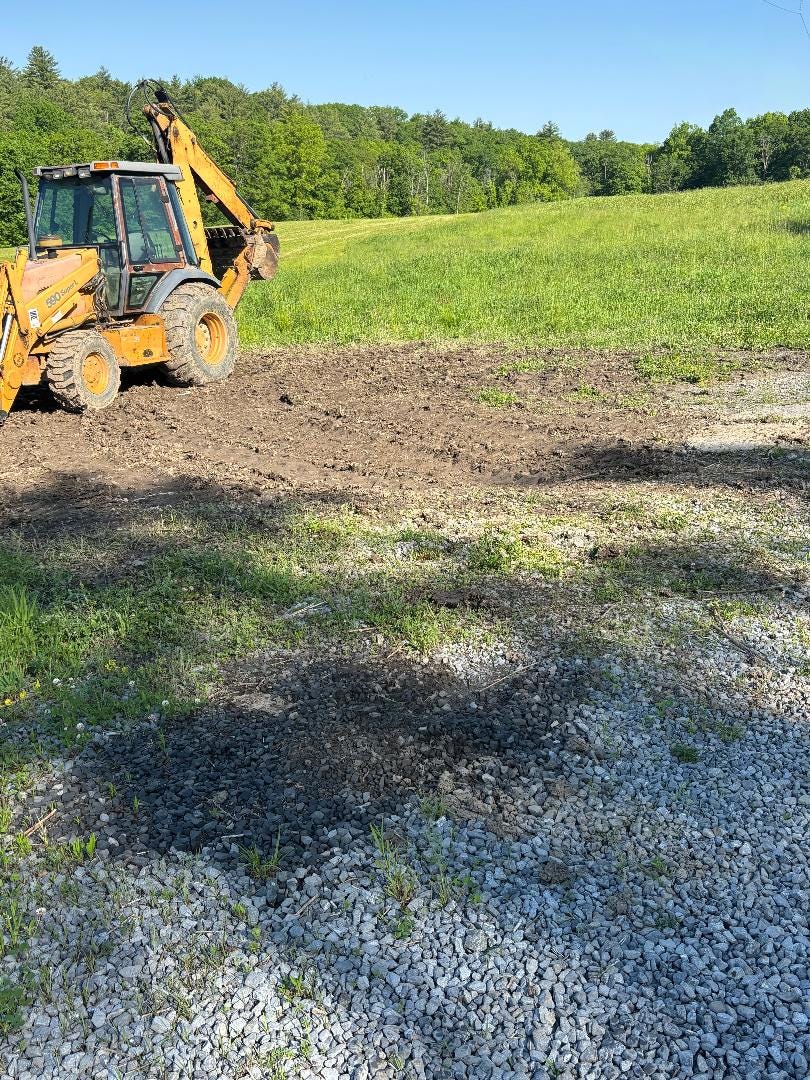Heartbreak and Hope: The Lesson of the Killdeer
A mother Killdeer tends to her eggs
I spend hours every day pouring through news reports and analysis of events transpiring around the world. Often, the information that comes across my desk represents the worst that humans can do to one another—war, famine, death, and destruction dominate the headlines. At times the negativity and sorrow these stories generate can become overwhelming. This is why I look forward to my morning walks with my dogs—it provides a much-needed opportunity to recharge my life batteries with the “good stuff”.
Every morning before the work day begins, my wife, Marina, and I load our four dogs—two Pomeranians (Maverick and Iceman), a Chihuahua (Machismo) and a mixed breed Shephard named Teegan—into our car and head to a local park where we can enjoy a stroll outdoors, surrounded by nature, while the dogs can roam and explore free of the constraints of a leash.
The Ritter dogs at the park: (left to right) Machismo, Iceman, Maverick and Teegan
The park is blessed with an extravaganza of flora and fauna native to upstate New York—we have crossed paths with deer, fox, skunks, rabbits, snakes, squirrels and chipmunks. It is also a favorite place for local Ornithologists to sharpen their birdwatching skills, as the park is home to numerous birds native to the region: American Bald Eagles, Red-Tailed Hawks, Ospreys and Great Horned Owls fly overhead, looking for prey, while Mallard, Wood Ducks, Green-Winged Teals, and Canadian Geese make their home along the banks and in the waters of the Normans Kill Creek. And all around us one can see Robins, Starlings, Sparrows, Cardinals, Red-Wing Blackbirds, Woodcocks, Crows and numerous other species of birds—including the Killdeer.
The Killdeer is a large Plover which makes its nest in short vegetation where the female can lay her clutch, usually comprised of four to six beige eggs with dark markings. Albany is known for its cold weather, meaning that the Killdeer tend to delay laying their eggs until well into May, once the temperatures start to warm up.
I always know when it is nesting time for the Killdeer because of the loud and active interaction the birds have with my dogs, who invariably come close to the eggs of a nesting pair, prompting a display of the various techniques the Killdeer use to distract potential predators and lure them away from the nest and its eggs.
Because of the cold temperatures this year, I didn’t experience the Killdeer’s repertoire of distractions and noise until last week when, for the first time this year, my four dogs encountered the shrill cry of a male Killdeer and he simulated a broken-wing, dragging one appendage on the ground while crying out in simulated pain.
It worked like a champ—all four dogs took off after the “injured bird”, only to discover that he was miraculously healed at the last moment, taking to the air to lead my four miscreants even further from the territory where his mate was tending to her eggs. I scanned the field to my left, looking for the mother bird, only to be startled myself as I approached her nest, which was situated just off the edge of the gravel path which constituted the park’s perimeter. The mother bird immediately spread her wings, exposing the orange feathers underneath, catching my attention before shrieking and running off. I looked down at me feet and saw what she was desperately trying to protect—her four perfectly formed eggs, sitting exposed in the short grass.
The four Killdeer eggs
I immediately walked away, only to notice that the father bird, having led my dogs away from the nest, had returned, summoned by the shrill cry of his mate, and began rushing at me to catch my attention. I carefully moved away from the eggs, and headed up the path, calling for my dogs to join me. I looked back to see the mother had returned to her nest, where she nestled herself over the eggs, continuing the incubation of her charges.
Later, as I made my way down the hill, I did my best to distract my dogs away from the nest, situated as it was so close to the trail. But I needed not to have fretted—the mother and father Killdeer worked their distraction magic, ensuring that all four dogs were lured away from the nest.
The next day Marina and I once again transported the dogs to the park, and once again we were confronted by the Killdeer nesting pair, who entertained us with their antics as we walked past their exposed and vulnerable nesting site. We weren’t the only dog owners to frequent the park—at any moment, there could be a half dozen owners and their dogs taking the scenic walk around the premises. This meant the Killdeer pair were working overtime to protect their eggs.
The Killdeer mother on her eggs, next to the gravel path
I made a point of mentioning the nest to the other dog owners I came across, to alert them to the precarious location of the nest. To my surprise and joy I found that most of them were aware of the nest and took similar precautions to avoid any tragic encounters between their pets and the eggs.
This past Saturday the weather took a turn for the worse, with the temperature falling into the low 40’s and the sky opening, unleashing a torrential rain. Normally my wife and I would stay home, not wanting either we or the dogs to become soaking wet and miserable. But I was drawn to the park out of concern for the Killdeer pair and their eggs. The morning proved to be as miserable as we had thought it would be—even the dogs were not enthusiastic about getting out of the dry car and venturing out into the pouring rain. But I was on a mission, and I threw the hood of my rain jacket over my head and made my way up the gravel path, only to be rewarded by the shrill cry of the father as he tried to get my attention, and the plaintive look of the mother, soaking wet, as she sat on her clutch shielding them from the elements.
The mother Killdeer, in the rain, protecting her eggs
Marina and I had a busy day ahead of us, trying to take care of all the little things associated with owning a home that are shunted to the side during the hustle and bustle of the work week. But as busy as we were, I just couldn’t get the mother killdeer out of my mind. The nest was so exposed, and I worried about her precious eggs, knowing that she and her mate would need to watch over them for nearly three more weeks before they would hatch. I watched the rain form into rivulets of rushing water around my neighborhood and had visions of the Killdeer nest being swept away by the water.
Come Sunday morning I awoke with more energy than usual, anxious to get to the park and check on “my” Killdeer and “our” eggs. I let the dogs out of the car and awaited the frantic cries of the father Killdeer as he engaged them to distract them away from the nest.
All I heard was silence.
My heart was in my throat as I approached the nesting area, scanning the ground for some sign of life.
And there she was, the mother bird, still nestled on her eggs.
She looked at me, and let out a little peep, letting me know I was getting too close.
It was the most beautiful sound in the world.
The mother Killdeer chirps out a warning
Marina and I discussed the Killdeer nest and brainstormed about what we could do to protect it. One idea was to place plow marker flags around the periphery of the nest to draw attention to the fact that there was a nest located next to the path. I figured that would cause someone to pause and buy time for the Killdeer pair to make their presence known. I decided that I would pace off the site and determine how many markers I would need before heading off to the local hardware store to buy them.
Monday morning came in sunny and warm, a much-needed break from the cold, wet weather that had plagued us for the past two weeks. I drove up to the spot where we normally parked our car, well below the stretch of field where the Killdeer nest was situated and let the dogs out.
Immediately I sensed something was wrong.
The dogs had made their way up the hill, toward the nest, and there was no sound at all from the Killdeer pair. And as my eyes tracked the movement of my dogs, I suddenly realized that I wouldn’t have to worry about buying marker flags for the nest anymore.
Parked in the field, just off the edge of the gravel path, was a large yellow earthmover. Across the path was a natural gas pipeline maintenance facility. Back in April the City of Albany had granted the operator of this facility an easement on property adjacent to the park for the purpose of replacing a section of pipeline. The earthmover was part of the equipment being brought in to accomplish this work.
The earthmover and the destroyed nesting ground
As I traced the route it took to cross the gravel path to where it was now parked, I saw that it had driven directly over the Killdeer nest.
All I could think about was the loyal mother Killdeer, who had remained on her clutch of eggs during the torrential rainstorm.
Who had stared me down the next day, refusing to leave her eggs unattended.
I made my way to where they nest used to be, digging through the mud thrown up by the large rubber wheels of the earthmover, looking for any evidence of the mother bird or her eggs.
There was nothing.
I was struck by a deep, profound sense of sadness and anger. At a time when the headlines proclaimed more death and destruction in Russia, Ukraine, and Gaza, the Killdeer pair and their eggs had become a beacon of light in an otherwise dark and dreary world.
I wanted those eggs to hatch and bring forth life, proving again the miracle of God’s vision when he created this world that we humans were trying so hard to destroy.
I needed those eggs to hatch.
And now they were gone.
I called to my dogs, and headed back to my car, my day no longer brimming with the joy that the Killdeer had injected into my life.
My two Pomeranians, Maverick and Iceman, were in their typical fashion, lagging. I turned my attention to them, calling out their names, when I realized they were chasing something.
It was the father Killdeer.
I walked toward where my two dogs were chasing after the father when I heard a peep to my right. I looked, and it was the mother. She had flown in to join the father in moving my dogs away from a stretch of field, further removed from the path, they had apparently marked out as their territory.
As relieved as I was to see that both were alive, my spirit was crushed at the thought of them going through the motions of protecting a nest that no longer existed.
Filled with a sense of profound sadness, I took it upon myself to read up about Killdeer, so that I might better understand why they had put the nest where they did. The circle of life is something that I am very familiar with, and I fully comprehend that life is fragile, and can be extinguished in a blink of an eye, especially for those animals and birds who live in the wild.
I wanted to know why they remained near the site of their destroyed nest.
Could birds mourn the loss of their eggs? I knew it was foolish to project human emotions on the Killdeer pair, but I was searching for some meaning in what had happened in the field this very morning.
The mother Killdeer protecting her former nesting area
My research led me to a passage which explained that while a Killdeer breeding pair would normally only produce one clutch of eggs per breeding season, if their first clutch were to be eaten or otherwise destroyed early in the breeding season, then the Killdeer would often lay a second clutch of eggs.
This explained the behavior of the Killdeer pair—they weren’t defending a ghost nest but rather staking their claim to a new nesting site. If things went well, in a week or so I should expect to be confronted with a father Killdeer perfectly executing the broken-wing technique to draw my dogs away from the area of the field where the mother Killdeer sat watch on her eggs, incubating them until the moment the miracle of life brought forth the next generation of chirping, fleeting, flying beauties.
Life, given its finite nature, is about the inevitability of heartbreak—ashes to ashes, dust to dust.
But even as death waits on the horizon for us all, it is the miracle of life that gives us both hope for the future and a reason to go on, regardless of the obstacles placed in our way.
We march forward, each day leading to an inescapable destiny, driven not by the despair of our impending doom, but rather the joy of the gift of life we have been given.
Life isn’t fair.
And it often results in tragedy.
But the act of living, of going through the motions of life, is what brings joy into this world.
Keep striving.
Never give up.
No matter what life throws at you..
This is the lesson of the Killdeer.
And it is one I will take forward for the rest of my days.





























